
- முகவரி: த.பெ. இல. 11, கண்ணொருவ, பேராதெனிய, இலங்கை.
- மின்னஞ்சல் : director.hordi@doa.gov.lk
- தொலைபேசி :(+94) 81-2388011-12-13
- தொலைநகல்:(+94) 81-2388234
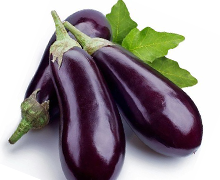
கத்தரி
Solanum melongena
கத்தரி அதிக சந்தை பெறுமதி கொண்ட ஒரு சத்துமிக்க பயிராக கருதப்படுகிறது.
தொடர்புடைய வர்க்கங்கள்
காலநிலை தேவை / செய்கைக்கு பொருத்தமான பிரதேசங்கள்
பயிர் கடல் மட்டத்தில் இருந்து 1300 மீ க்கு மேல் மட்டத்தில் வளரும்.
மண்
நல்ல நீர் வடிந்தோடக்கூடிய மண் பொருத்தமானது, 5.5 – 5.8 வரையான ph அளவு
விதை தேவை
350g/ha
நாற்றுமேடை முகாமைத்துவம்
பொருத்தமான சூரிய ஒளியில் 3m x 1m பாத்தி பொருத்தமானது. பாத்தி தொற்றுநீக்கப்பட வேண்டும். மேல் மண் மற்றும் மாட்டெரு 1:1 எனும் விகிதத்தில் இட வேண்டும். விதைகளை வரிசைகளுடாக 6 அங்குல இடைவெளியில் இட வேண்டும்.
நிலத்தை தயார் செய்தல்
பூச்சிய பண்படுத்தல் அல்லது உழுதல் செய்த மண்ணில் 30m x 30m x 30m அளவில் குழிகளை தயார் செய்ய வேண்டும்.
நடுகை செய்தல்
தயார் செய்யப்பட்ட குழிகளில் 25 – 30 நாட்களான பயிர் நாற்றுகளை குழிக்கு ஒன்று எனும் வகையில் பயிரிடலாம்
நடுகை இடைவெளி
90cm x 60cm
பசளையிடல்
பசளை இட வேண்டிய காலம் | யூரியா kg/ha | முச்சுபர் பொசுபேற்று kg/ha | மியூரியேட் ஒப் பொட்டாசு kg/ha |
| அடிக்கட்டு பசளை | 75 | 325 | 85 |
| 4 வாரங்களின் பின் | 75 | – | – |
| 8 வாரங்களின் பின் | 75 | – | 85 |
நீர் வழங்கல்
நல்ல வளர்ச்சிக்கு நல்ல நீர் வழங்கல் தேவை
களைக் கட்டுப்பாடு
நடுகை செய்து 2,4,7,9,12 நாட்களின் பின் களையகற்றல் நன்று
Pest Management
நோய் முகாமைத்துவம்
- பங்கசு நோய்கள்
- நாற்றின் தண்டின் அடிப்பகுதியில் சடுதியாக சரிதல்
- வேரழுகல் மற்றும் நாற்று இறப்பு
- அடிப்பகுதியில் Rhizoctonia spp இனால் கபிலம் சார்ந்த கருப்பு நிறமாற்றம்
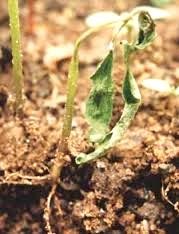 |
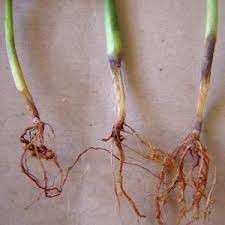 |
- நல்ல நீர்வடிப்புள்ள ஆரோக்கியமான மண்ணில் பாத்தியமைத்தல்
- நாற்றுமேடை தொற்றுநீக்கம் -எரித்தல், சூரியவெப்பப்படுத்தல் அல்லது இரசாயன பாவனை
- பாதிக்கப்பட்ட தாவரத்தை சூழவுள்ள மண்ணுடன் அகற்றல்
- விதை சிகிச்சை (நடுவதற்கு முன்னர் செய்ய வேண்டும்)
- மண் சிகிச்சை- தாவரத்தை சூழ காண் அமைத்து பரிந்துரைக்கப்பட்ட பங்கசு நாசினியை குறித்த பயிருக்கு வழங்கலாம்.
- இலைகள் மஞ்சளாதல்
- கழுத்து பகுதியில் சிதைவு ஏற்படல்
- கழுத்து பகுதியில் Mycelia mat உடன் வெள்ளை / கபில Sclerotia
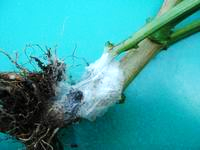 |
- பாதிக்கப்பட்ட தாவரத்தை சூழவுள்ள மண்ணுடன் அழித்தல்
- வடிகாலைமேம்படுத்தல்
- மண்ணை அழமாக உழுது பாதிக்கப்பட்ட மண்ணை நல்ல சூரிய வெளிச்சத்துக்கு உட்படுத்தல்
- நாற்று நடுகையின் போதான வேர் பாதிப்பை தவிர்த்தல்
- மண் சிகிச்சை – தாவரத்தின் அடிப்பகுதியை சூழ காண் அமைத்து பரிந்துரைக்கப்பட்ட பங்கசு நாசினியை தனித்தாவரத்திற்கு இடல்
நோய் காரணி : Fusarium oxysporum f.sp lycopersici
அறிகுறிகள்:
- இளைகள் மஞ்சளாகி வாடல்
- தண்டு குழாய் நிறமாற்றம்
- வேர்கள் அழுகி தாவரம் இறத்தல்
முகாமைத்துவம்
- பாதிக்கப்பட்ட தாவரத்தை சூழவுள்ள மண்ணுடன் அழித்தல்
- வடிகாலை மேம்படுத்தல்
- நிலத்தை ஆழமாக உழுதல் மற்றும் பாதிக்கப்பட்ட மண்ணை நல்ல சூரிய ஒளிக்கு உட்படுத்தல்
- நாற்று நடுகையின் போது வேர் பாதிப்பை தடுத்தல்
- மண் சிகிச்சை தாவரத்தின் அடிப்பகுதியை சூழ காண் அமைத்து பரிந்துரைக்கப்பட்ட பங்கசு நாசினியை தனித்தாவரத்திற்கு இடல்
-தியோபனேற் – மெதைல் 50% WP + திராம் 30% WP – 50g / 50 லீ / 10m2
-திராம் 80% WP – 70g / 50 லீ / 10m2
-கெப்டான் 50% WP – 60g / 50 லீ / 10m2
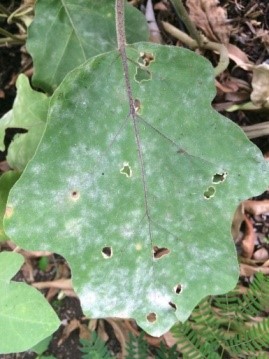 |
- இலைகளின் கீழ் புறத்தில் வட்டவடிவ மஞ்சள் ஒட்டு அல்லது புள்ளி தோன்றல்
- இலை மேற்பரப்பில் வெள்ளை தூள் மிகுதி காணப்படல்
- நோய் விருத்தியடையும் ஆரம்ப நிலையில் பரிந்துரைக்கப்பட்ட பங்கசு நாசினி பாவணை (குறிப்பு DOA பீடைநாசினி பரிந்துரை, 2019)
- 10 l நீருக்கு 50g சல்பர் 80% WP சேர்த்தல்
- குளோரோதலொனில் 500g /l SC – 30 ml / 10 லீ நீருக்கு
- கார்பென்டசிம் 50% WP – 7g / 10 லீ நீருக்கு
- நடுவில் பழுப்பு முதல் செம்மஞ்சள் கபிலம் செறிவான வளையங்களுடனான குழிவான வட்ட காயங்கள்
- காயங்களில் வெளியேற்றத்துடன் இளஞ்சிவப்பு கொனிடியா உறுப்பினருடனான பெருக்க உறுப்புகள்
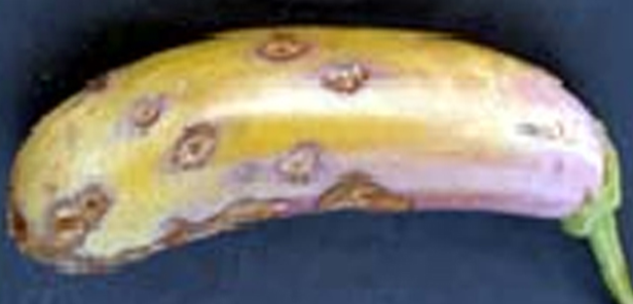 |
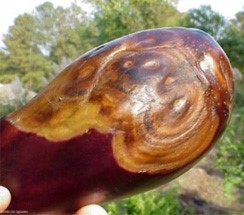 |
- ஆரோக்கியமான வித்து பாவணை
- அதிகபடியான நீர்பாசனத்தை தவிர்த்தல்
- பாதிக்கப்பட்ட பழங்களை அகற்றி அழித்தல்
- வித்து சிகிச்சை (நடுகை செய்ய முன் வழங்க வேண்டும்)
- மழை காலங்களில் பூக்கும் ஆரம்ப நிலையில் பங்கசு நாசினி தெளித்தல்
- தண்டு மற்றும் இலைக்காம்புகளில் கருப்பு விளிம்புடைய சாம்பல் புள்ளி கொண்ட சிறிய புற்றுகள் காணப்படும்
- Pycnidia விருத்தியால் புள்ளியின் மையம் சாம்பல் மற்றும் கருப்பு நிறமாதல்
- மென்மையான மற்றும் நீர்பாங்கான பழ புள்ளிகள் கருப்பாக மற்றும் உள்ளீடு அற்றவையாதல்
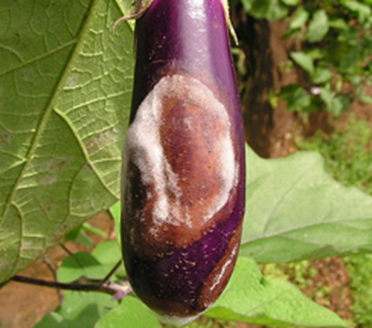 |
- பாதிப்புற்ற பழங்களை அகற்றி அழித்தல்
- நோய் விருத்தியுரும் ஆரம்ப நிலையில் பரிந்துரைக்கப்பட்ட பங்கசு நாசினியை பிரயோகித்தல் (குறிப்பு – DOA பீடைநாசினி பரிந்துரைட 2019)
- பற்றீரயா நோய்கள்
- தனி கிளை / கிளைகளில் சிறியளவு வாடல்
- சடுதியான மற்றும் நிரந்தர தாவர வாடல்
- இழைய நரம்பு நிறமாற்றம்
- பாதிக்கப்பட்ட தாவர பகுதியை வெட்டி நீரில் இடும் போது மெல்லிய பிசுபிசுப்பான பற்றீரிய திரவம் வெளியேரும்
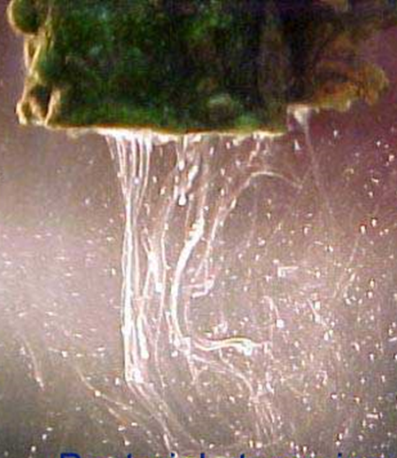 |
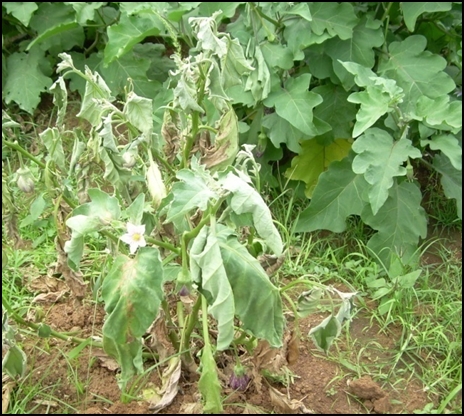 |
- பாதிக்கப்பட்ட தாவரத்தை மண்ணுடன் அகற்றி அழித்தல்
- அறுவடையின் பின் பயிர் மிகுதிகளை அழித்தல்
- நோயிற்கு உள்ளாக கூடிய பயிர்களை பயன்படுத்தி (குருசுபெரஸ் மரக்கறி மற்றும் வெண்டி) பயிர் சுழற்சி முறை செய்வதால் நோய் பரவலை குறைக்க முடியும்
- பரிந்துரைக்கப்பட்ட வர்க்கங்களின் பாவனை
- பயன்படுத்திய பின் அனைத்து பண்ணை உபகரணங்களையும் சுத்தம் செய்து தொற்று நீக்கம் செய்ய வேண்டும்.
- இரசாயன கட்டுப்பாட்டு முறை இல்லை
- டைடோபிளாஸ்மா நோய்
- இலைகள் குறுகி, மென்மையாகி, வழுவழுப்பாகி மற்றும் மஞ்சளாகும்
- தண்டின் கனுவிடைகள் குறுகும்
- துணை மொட்டுகள் பெரிதாகும் ஆனால் அவற்றின் இலைக் காம்பு மற்றும் இலைகள் குறுகும் மற்றும் தாவரம் கொத்து போன்று தோன்றும்
- பூக்கள் பச்சை நிறமாகும் / பூக்காது
- அரிதாக காய் உருவாகும்
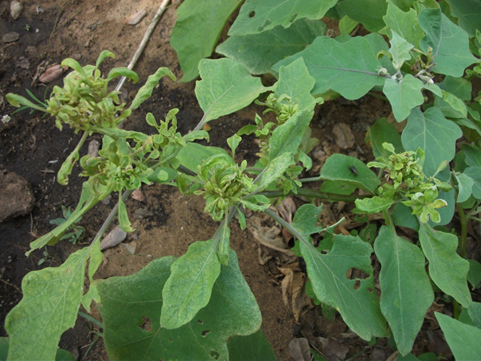 |
- பாதிக்கப்பட்ட தாவரத்தை அகற்றி எரித்தல்
- பரிந்துரைக்கப்பட்ட பூச்சிநாசினி பாவணை மூலம் இலை தத்தியை கட்டுப்படுத்துவதால் நோய் பரவலை குறைக்கலாம்.
அறுவடை
நாற்று நடுகை செய்து 10-12 வாரங்களில் அறுவடை செய்யலாம். 7 நாள் இடைவெளியில் அறுவடையை 10 – 12 பறித்தலில் செய்யலாம்.
விளைச்சல்
வர்க்கத்தை பொருத்து சாதகமான விளைச்சல் காணப்படும். OPV 18-20t/ha தரும் மற்றும் கலப்பினம் 30-40 t/ha தரும்
